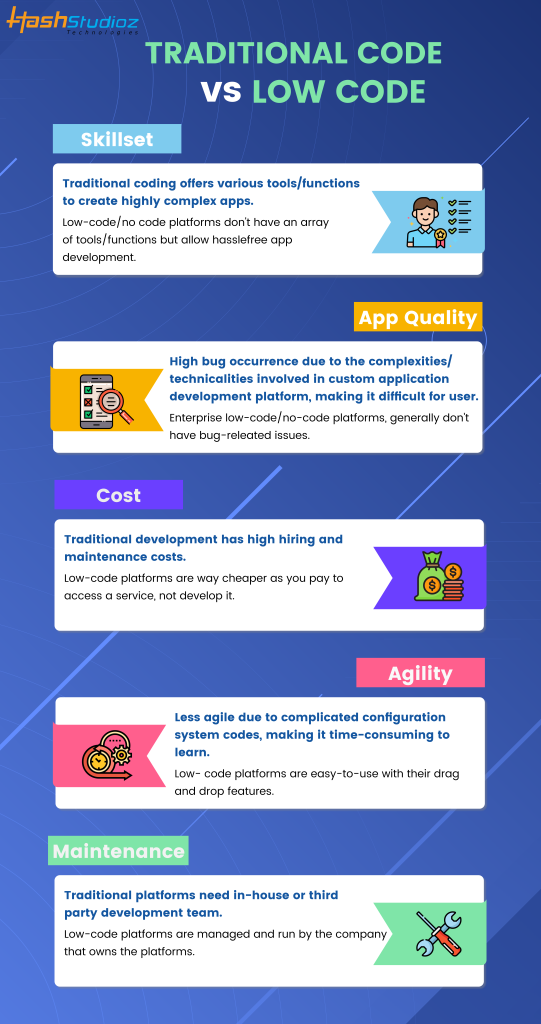Visual Development Environment (VDE):
Drag-and-Drop Interfaces: Low-code platforms provide visual tools for designing applications. Drag-and-drop tools allow developers to rapidly assemble applications, without needing to write code.
Pre-built Templates and Components: A number of low-code platforms include already-built templates and components that allow developers to quickly prototype and build applications without starting from the beginning.
Reduction of Coding Requirements
Automated Generated Code: Lowcode platforms create the underlying code based off the visual models created developers. This helps reduce manual code, and speeds the development process.
Reusable components: Developers have the ability to use reusable component across multiple projects, which reduces the time they spend writing and testing code.
Collaboration is made easier:
Low-code development platforms are usually equipped with tools, such as deployment, version control, and testing. This allows seamless collaboration across teams.
Citizen Development: Non-developers as well as business users can benefit from simple interfaces to help in the creation of applications, which can reduce bottlenecks caused due to a shortage of professionals to develop applications.
Rapid Iteration and Prototyping
Rapid prototyping. Developers can design prototypes quickly in order to test their ideas and receive feedback. This leads to a quicker iteration process.
Easy Modifications. The visual nature low-code development gives allows users to easily modify and update applications. This speed up the process of improving and refining applications based on feedback from users.
Pre-built Integrations:
API Integrations. Low-code platforms usually come with pre-built connectors as well as APIs for services that are popular that reduce the time needed to connect other systems.
Data Integration: Built in tools for data-integration make it easier to connect databases and other data sources. This helps speed up development.
Scaling, deployment and deployment
One-Click deployment: Many platforms that make use of low-code have an option to deploy applications, reducing time and effort.
Cloud-based solutions: Cloud low-code platforms are capable of the management of infrastructure and scaling. Developers can concentrate on application logic and functionalities rather than deployment logistic.
Overall, the rapid development of low-code apps lies in its ability simplify and automate many aspects of the application development process. This facilitates faster development of apps as well as quicker adaptation to changing requirements. Read the best Low-code Platform for application development info for website tips including mobile development platforms, develop mobile application, app modernization, azure sql server, no code platforms, application modernization, low code development platforms, rapid app development, cross platform mobile development, low code platforms and more.

Advantages Of Low-Code Application Development In Terms Of Governance And Security
Low-code app development provides several benefits for security and governance. This is vital to ensure that apps conform to regulations, are secure and are well managed throughout their life. Here are a few of the main benefits.
Unified Management Console: A low-code platform often provides a centralized dashboard that administrators can use to control and monitor all applications, ensuring consistency governance across the organisation.
Role-Based Access Control: These platforms include robust role-based control that allows administrators to define policies and enforce these policies. Only authorized users are able to alter or access specific parts of a program.
Compliance and Regulatory Adherence:
Many low-code platforms include integrated compliance features. For instance, they are developed in accordance with the industry standards regulations, laws and standards (e.g. HIPAA, GDPR). They offer frameworks and instruments to ensure that the applications are compliant with specifications.
Audit Trails and Logging Audit trails and logs that are comprehensive are often combined, allowing businesses to track changes, monitor access and make sure that they are in compliance with internal and external laws.
Additional Security Measures
Data encryption: Low-code platforms generally provide encryption built-in for data in transit and during transit, which ensures that sensitive information is protected.
Security Certificates: A lot of low-code providers have a security certificates (e.g. ISO 27001 and SOC 2) which demonstrate they adhere to the strictest security standards. They offer an additional security level to their clients.
Automatic security updates for security:
Regular Patching and Updates Low-code platforms usually handle regular patches and updates to security automatically, making sure applications are secure from most recent threats, without the need for the intervention of developers.
Security Monitoring Tools: These tools give alerts in real time and insights into security concerns that might be present.
Data Governance
Data Access Policies: These platforms help organizations determine and enforce their data access policy to ensure that only authorized users are able to access information and that it's properly used.
Data Masking and Anonymization: Tools built in to mask data and safeguard sensitive data, particularly in development environments and testing environments.
Consistent Lifecycle Management of Applications:
Pipelines for Deployment and Development: Low-code platforms often provide integrated development and deployment pipelines which include security checks to ensure that security is maintained throughout the entire application lifecycle.
Version Control: An integrated version control allows for the management of modifications. It also ensures that all changes to the software are tracked, and if needed reversed. This is to ensure the security of the program.
User Authentication and Authorization:
Single Sign-On Support for single sign-on (SSO), and other advanced mechanisms of authentication, simplifies management and increases security.
Multi-Factor Authentication : Many platforms include built-in multi-factor authentication, providing additional security for accessing applications.
Monitoring Policy Enforcement:
Policy Templates: Low code platforms usually have pre-defined templates for security and governance that enable organizations to quickly implement policies.
Tools for Monitoring Compliance: These instruments provide continuous monitoring, reporting and analysis of compliance status. It is easier to spot potential issues and take proactive actions.
Integrate with the existing security infrastructures:
Seamless integration: Low-code platforms can easily be integrated into the existing security tools and systems such as firewalls and SIEM products (Security Information and Event Management), and identity management systems.
API Security: API integrated security ensures integrations with external systems are secured. Secure data and ensure the consistency of your application.
Training and Best Practices
Guided Best Practices: Many platforms provide guidelines and best practices for secure application development, helping non-developers adhere to security guidelines.
Security Training: Some companies of low-code offer education and resources in security to educate users about how to design and develop secure applications.
Overall, the application's governance and security advantages assure that applications are built and managed securely and in accordance with regulations and in control. These platforms contain the tools and frameworks required to oversee and manage development of applications, as well as secure sensitive data, while ensuring the compliance of regulations and enforcing rules. Have a look at the recommended her latest blog about Legacy application modernization with Low-code for more tips including build with docker, application modernization software, rapid action development, rapid action development, develop mobile application, rapid app development, app platforms, stored sql procedures, cross platform mobile dev, low code development platforms and more.

Benefits Of Low-Code Application Development In Terms Of Community Support And Vendor Support
Low-code development platforms for applications can be a fantastic option to obtain vendor support and community participation. Both of these factors are vital for ensuring a successful implementation and ongoing maintenance of the app. Support for Vendors
Comprehensive Technical Support:
Support Teams Dedicated to You Many low-code platforms offer special support teams that are able to assist with technical issues, problem solving and provide guidance. This will ensure that any issues will be quickly solved.
Certain vendors offer support 24 hours a day. This can be very advantageous for companies operating across time zones.
Training and onboarding:
Formal Training Programs: Many vendors provide a structured and organized training program which include webinars, tutorials and certification courses to help users get up to speed on the platform quickly.
Many vendors provide personalized onboarding to help customers make use of their platform effectively and tailor it to their requirements.
Regular Updates & Enhancements
Continuous Improvement : Low-code platforms manufacturers often release regular updates that add new functionality as well as performance improvements and security patches. These updates ensure that their platform remains up to date and secure.
Feedback Integration: Vendors typically incorporate user feedback into their development cycles, making sure that their platforms evolve to meet the changing demands of its customers.
Comprehensive Documentation:
User documentation in detail Users can get answers to their issues by reading the detailed and well-organized manual that covers all aspects of the program starting from its basics to more advanced customisation.
API References API documentation provides complete API references to assist developers connect their low-code platform apps with other platforms.
Consultancy and Professional Services
Expert Consulting: Vendors typically provide consulting services to help with planning for strategic purposes, architecture design, and complex implementations, ensuring that users have the ability to leverage the platform to its fullest potential.
Custom Development Services A few vendors offer customized development services to develop specific features and integrations which are not included in standard.
Community Support
Active User Groups:
Forums and Discussion Boards A lot of low-code platforms offer vibrant online communities where users can ask questions, share solutions, and collaborate on the best practices.
User Groups and Meetings Both local and virtual meetings and groups of users give you the chance to study about, network, and share experiences with other users.
Collaboration and knowledge sharing:
Community-Contributed Resources: Users often share templates, modules, and extensions that they have developed, which can be reused or adapted by others, accelerating development and innovation.
Crowdsourced Problem Solving: The collective wisdom and experience of the crowd can be a great source of troubleshooting and figuring out creative solutions for difficult issues.
Learning and Development
Community-led Training: Many groups organize workshops, sessions for training, and webinars. They are typically conducted by experts in the field, who offer practical insight and advanced techniques.
Tutorials and Online Courses: Community members frequently make and share online tutorials, courses, and how-to guides, improving the resources for learning accessible to all users.
Feedback and Influence
Forums for Product Feedback: These forums often include channels for providing feedback to the vendor which may influence the design of new features and improvements.
Beta Testing members of active communities could be able to be part of the beta testing process. This allows them to get early access to the platform and participate in the creation of the platform.
Recognition and encouragement:
A lot of vendors offer community recognition programs. These programs recognize active community members, and can include MVP programs.
Peer Support. Community members offer peer-to-peer support. They offer their expertise with users who are less familiar and provide guidance. This creates an atmosphere that is supportive and collaborative.
Overall, a strong vendor's support and a vibrant, active community provide a comprehensive support system for low-code development. It ensures that the users have access to the resources as well as the expertise and collaboration opportunities needed to successfully develop, deploy, and maintain their applications improving the efficiency and effectiveness of their applications.
